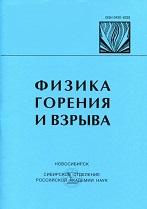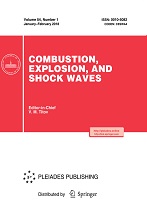|
This article is cited in 3 scientific papers (total in 3 papers)
Modeling of shock wave initiation of an explosion of individual bubbles in liquid hydrocarbon fuels
P. A. Fominab
a Lavrentyev Institute of Hydrodynamics of Siberian Branch of the Russian Academy of Sciences, Novosibirsk, 630090, Russia
b Khristianovich Institute of Theoretical and Applied Mechanics, Siberian Branch of the Russian Academy of Sciences, Novosibirsk, 630090, Russia
Abstract:
A physicomathematical model of shock wave initiation of an explosion of oxygen-containing bubbles in liquid hydrocarbon fuels is developed. The model is used to calculate an explosion of bubbles in which the initial concentration of fuel vapors is outside the flammability limits. A principal possibility of condensation of fuel vapors during compression of a fuel-rich bubble located in liquid cyclohexane with a comparatively high initial temperature is demonstrated. Condensation leads to a decrease in the fuel concentration in the gas lower than the fuel-rich flammability limit. As a result, an explosion of an initially non-combustible bubble becomes possible. The condensation rate is estimated. It is found to be sufficiently high to change the chemical composition of the gas during the period of the first oscillation of the bubble. The explosion limits of the bubble are calculated as functions of the initial pressure, temperature, and amplitude of the shock wave. If condensation is taken into account, the explosion limits are expanded. Bubble liquids (2-ethylhexanol and isopropyl benzene) where the fuel vapor concentration is initially lower than the fuel-lean flammability limit are considered. It is shown that liquid evaporation induced by mechanical mixing of the phases can shift the chemical composition of the gas inward the flammability region, resulting in a bubble explosion with a corresponding increase in gas temperature. Calculated and experimental results are found to be in good agreement. Explosive processes in bubble media containing a liquid monopropellant are considered at the qualitative level for the first time. An assumption is put forward about a possibility of multiple explosions of an individual bubble loaded by a series of shock waves and subjected to multiple transitions of the detonation wave over the liquid with distributed bubbles, which may be used for generating a series of powerful acoustic signals in the ambient space.
Keywords:
bubble mixture, explosion limit, explosion safety, mathematical modeling.
Received: 24.10.2013
Revised: 26.11.2013
Citation:
P. A. Fomin, “Modeling of shock wave initiation of an explosion of individual bubbles in liquid hydrocarbon fuels”, Fizika Goreniya i Vzryva, 50:6 (2014), 75–91; Combustion, Explosion and Shock Waves, 50:6 (2014), 689–703
Linking options:
https://www.mathnet.ru/eng/fgv187 https://www.mathnet.ru/eng/fgv/v50/i6/p75
|


|





 Contact us:
Contact us: Terms of Use
Terms of Use
 Registration to the website
Registration to the website Logotypes
Logotypes








 Citation in format
Citation in format 
